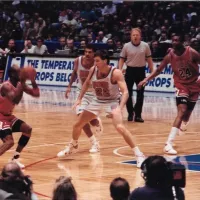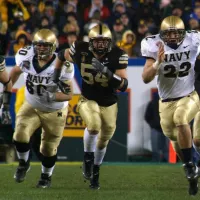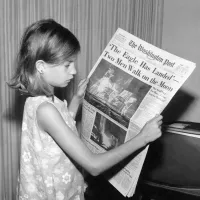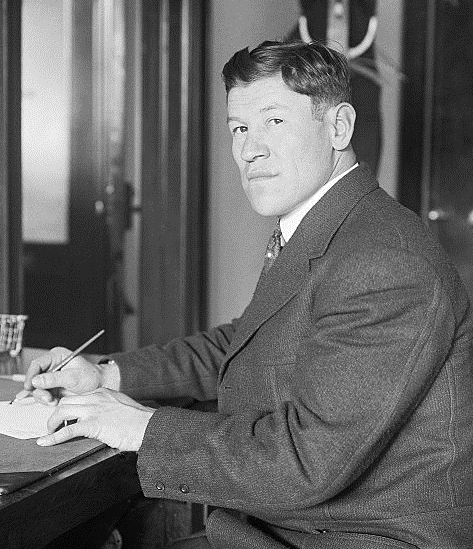Jim Thorpe, a Sac and Fox Nation citizen, was a versatile American athlete renowned for his accomplishments in multiple sports. He achieved international fame by winning two gold medals at the 1912 Summer Olympics, marking him as the first Native American to win Olympic gold for the United States. Beyond the Olympics, Thorpe also excelled in professional football, baseball, and basketball, solidifying his legacy as one of the greatest and most adaptable athletes in sports history.
1904: Decathlon at St. Louis Olympics
A men's version of the decathlon had been featured on the program of the 1904 St. Louis Olympics. The events of the new decathlon differed slightly from the American version.
1904: Attending Carlisle Indian Industrial School
In 1904, at the age of 16, Jim Thorpe returned to his father and decided to attend Carlisle Indian Industrial School in Carlisle, Pennsylvania, where his athletic ability was recognized by coach Pop Warner.
1906: Introduction of Pentathlon
A pentathlon, based on the ancient Greek event, had been introduced at the 1906 Intercalated Games. The 1912 version consisted of the long jump, javelin throw, 200-meter dash, discus throw, and 1500-meter run.
1907: Start of Athletic Career at Carlisle
In 1907, Jim Thorpe began his athletic career at Carlisle, breaking the school's high jump record. His earliest recorded track and field results also come from this year.
1908: Third-Team All-American
In 1908, Jim Thorpe was named a third-team All-American in football.
1909: Playing Semi-Professional Baseball
In 1909, Jim Thorpe played semi-professional baseball in the Eastern Carolina League for Rocky Mount, North Carolina, receiving pay for his participation.
1909: Previous Record at Celtic Park
In 1909, Martin Sheridan set the previous record of 7,385 points at Celtic Park in the Amateur Athletic Union's All-Around Championship, before Jim Thorpe broke it in 1912.
1910: Not competing in track and field
In 1910, Jim Thorpe did not compete in track and field, though this would be the sport in which he gained greatest fame.
1910: Playing Semi-Professional Baseball
In 1910, Jim Thorpe played semi-professional baseball in the Eastern Carolina League for Rocky Mount, North Carolina, receiving pay for his participation.
1911: Nationwide Notice for Athletic Ability
In 1911, Jim Thorpe gained nationwide notice for his athletic ability, scoring all of his team's four field goals in an 18–15 upset of Harvard. He also rushed for 173 yards in the game.
1911: First-Team All-American
In 1911, Jim Thorpe was named a first-team All-American in football.
September 2, 1912: Amateur Athletic Union's All-Around Championship
On September 2, 1912, Jim Thorpe competed in the Amateur Athletic Union's All-Around Championship at Celtic Park in Queens, New York, winning seven of the ten events and breaking the previous record with a total point score of 7,476 points.
September 1912: King Gustav V's Compliment
In September 1912, at the closing ceremonies of the 1912 Olympic Games, King Gustav V of Sweden reportedly said to Jim Thorpe, "You, sir, are the greatest athlete in the world", while awarding him his prize for the decathlon.
1912: Participation in Multiple Olympic Events
During the 1912 Summer Olympics, Jim Thorpe competed in the decathlon, pentathlon, long jump, and high jump. He won the gold medal in the pentathlon on July 7 and qualified for the high jump final, finishing in a tie for fourth. On July 12, he placed seventh in the long jump.
1912: New Multi-Event Disciplines in the Olympics
For the 1912 Summer Olympics in Stockholm, Sweden, two new multi-event disciplines, the pentathlon and the decathlon, were included.
1912: Olympic Success and AAU Victory
In 1912, Jim Thorpe achieved Olympic success, including a record score in the decathlon. Following his Olympic performance, he added a victory in the All-Around Championship of the Amateur Athletic Union.
1912: Exhibition Baseball Games at the Olympics
In 1912, Jim Thorpe also participated in one of two exhibition baseball games at the Olympics, which featured teams composed mostly of U.S. track and field athletes.
1912: Victory Over West Point Army Team
In 1912, Jim Thorpe led Carlisle to a 27–6 victory over the West Point Army team. During the game, his 92-yard touchdown was nullified by a penalty, but he then rushed for a 97-yard touchdown on the next play.
1912: Leading the Nation in Touchdowns and Points
In 1912, Jim Thorpe led the nation with 29 touchdowns and 224 points scored during the season, according to the College Football Hall of Fame.
1912: First-Team All-American
In 1912, Jim Thorpe was again named a first-team All-American in football.
1912: Ballroom Dancing Championship
In 1912, Jim Thorpe won the intercollegiate ballroom dancing championship.
1912: Olympic Gold Medals
In 1912, Jim Thorpe won two Olympic gold medals at the Summer Olympics, one in the classic pentathlon and the other in the decathlon. This made him the first Native American to win a gold medal for the United States in the Olympics.
1912: Strict Amateurism Rules in Effect
In 1912, strict rules regarding amateurism were in effect for athletes participating in the Olympics, barring those who had received money prizes, were sports teachers, or had competed against professionals.
1912: Training for the Olympics
In the spring of 1912, Jim Thorpe began training for the Olympics, adding events like pole vaulting, javelin, discus, hammer, and 56 lb weight to his repertoire.
January 1913: Turns down St. Louis Browns, signs with New York Giants
In January 1913, Jim Thorpe declined a starting position with the St. Louis Browns and instead signed with the New York Giants baseball club, who were the defending National League champions.
January 1913: Newspaper reports on disqualification appear
In January 1913, newspaper reports surfaced about Jim Thorpe's disqualification, approximately six months after the Stockholm Games. These reports highlighted that the AAU and IOC had not followed their own disqualification rules.
January 1913: Report of Semi-Professional Baseball
In late January 1913, the Worcester Telegram reported that Jim Thorpe had played semi-professional baseball before the Olympics, which violated the amateurism rules and led to controversy.
1913: Amateur status restored
Before 1913, Jim Thorpe's amateur status was restored after the AAU and United States Olympic Committee overturned its decision.
1913: Married Iva Miller
In 1913, Jim Thorpe married Iva M. Miller, whom he had met at Carlisle.
1913: Signing with the New York Giants
In 1913, Jim Thorpe signed with the New York Giants and began his career in Major League Baseball, where he played for six seasons.
1915: Harvard's losing streak ends
In 1911, Jim Thorpe lead his team to upset Harvard. Harvard did not lose again until 1915.
1915: Joining the Canton Bulldogs
In 1915, Jim Thorpe joined the Canton Bulldogs American football team, contributing to their winning three professional championships.
1919: End of Baseball Career
Jim Thorpe's six-season career in Major League Baseball ended in 1919, after having started in 1913 with the New York Giants.
1920: President of American Professional Football Association
From 1920, Jim Thorpe was nominally the first president of the American Professional Football Association.
1921: President of American Professional Football Association
Until 1921, Jim Thorpe was nominally the first president of the American Professional Football Association.
1922: American Professional Football Association becomes NFL
In 1922, the American Professional Football Association, of which Jim Thorpe was president until 1921, became the NFL.
1948: Thorpe's Reply Surfaced
In 1948—36 years after his appearance in the Olympics—Thorpe's reply surfaced in newspapers.
1951: Portrayal in "Jim Thorpe – All-American"
In 1951, Jim Thorpe was portrayed by Burt Lancaster in the film "Jim Thorpe – All-American", which was about his life and athletic career.
1952: Thorpe's Reply in Books
By 1952, Thorpe's reply had surfaced in books.
March 28, 1953: Jim Thorpe's Death
On March 28, 1953, Jim Thorpe, a renowned American athlete, passed away. He was known for winning Olympic gold medals and playing professional football, baseball, and basketball. He was 65 years old at the time of his death.
1953: Death of Jim Thorpe
Jim Thorpe died in 1953, suffering from heart failure. He was married three times and had eight children.
1961: Eisenhower's Speech About Thorpe
In 1961, former President Dwight D. Eisenhower, who played against Jim Thorpe in 1912, recalled his impressions of Thorpe in a speech.
1963: Induction into Pro Football Hall of Fame
In 1963, Jim Thorpe was inducted into the Pro Football Hall of Fame as part of its inaugural class, recognizing his accomplishments in the sport.
April 16, 1973: "Jim Thorpe Day" Proclamation
On April 16, 1973, President Richard Nixon proclaimed "Jim Thorpe Day" to promote nationwide recognition of Thorpe's life.
1975: "Champions of College Football"
In 1911, Jim Thorpe lead his team to an 11-1 record. In 1975, Jim Thorpe's team was retroactively named national collegiate champions in a book titled "Champions of College Football", written by Bill Libby.
1983: Olympic Medals Restored
In 1983, 30 years after his death, the International Olympic Committee (IOC) restored Jim Thorpe's Olympic medals with replicas. This decision came after ruling that the initial decision to strip him of the medals fell outside of the required 30 days.
1986: Establishment of the Jim Thorpe Award
In 1986, the Jim Thorpe Association established the Jim Thorpe Award, an annual award given to the best defensive back in college football.
February 3, 1998: United States Postal Service Issued Stamp
On February 3, 1998, the United States Postal Service issued a 32¢ stamp commemorating Jim Thorpe as part of the Celebrate the Century stamp sheet series.
2000: Greatest Athlete of the Twentieth Century
In 2000, Jim Thorpe was voted the Greatest Athlete of the Twentieth Century in a poll of sports fans published by ABC Sports.
June 2010: Lawsuit Filed to Return Remains to Oklahoma
In June 2010, Jim Thorpe's son, Jack Thorpe, filed a federal lawsuit against the borough of Jim Thorpe, Pennsylvania, seeking to have his father's remains returned to his homeland and re-interred near other family members in Oklahoma, citing the Native American Graves Protection and Repatriation Act (NAGPRA).
February 22, 2011: Death of Jack Thorpe
On February 22, 2011, Jack Thorpe, Jim Thorpe's son, who was seeking to have his father's remains returned to Oklahoma, died at the age of 73.
April 2013: U.S. District Judge Ruled in Favor of NAGPRA Application
In April 2013, U.S. District Judge Richard Caputo ruled that Jim Thorpe borough amounts to a museum under the NAGPRA and therefore is bound by that law, which would allow the family to pursue the return of Jim Thorpe's remains to Sac and Fox land in Oklahoma.
October 23, 2014: Reversal of NAGPRA Ruling
On October 23, 2014, the United States Court of Appeals for the Third Circuit reversed the 2013 ruling and held that Jim Thorpe borough is not a "museum" under NAGPRA, preventing the plaintiffs from invoking the federal statute to seek reinterment of Thorpe's remains.
October 5, 2015: Supreme Court Refused to Hear the Case
On October 5, 2015, the United States Supreme Court refused to hear the matter, effectively ending the legal process to repatriate Jim Thorpe's remains.
2015: Proposed Designs of Native American Dollar Coin Released
In 2015, the proposed designs were released for the Native American dollar coin that would commemorate Jim Thorpe.
2018: AAU Gussie Crawford Lifetime Achievement Award and Native American Dollar Coin
In 2018, Jim Thorpe received the AAU Gussie Crawford Lifetime Achievement Award for his contributions to amateur sports, and he was commemorated on the Native American dollar coin.
2018: Induction into National Native American Hall of Fame
In 2018, Jim Thorpe was inducted into the National Native American Hall of Fame during the organization's inaugural induction ceremony.
2019: Inauguration of the Jim Thorpe Area Running Festival
In 2019, the Jim Thorpe Area Running Festival, featuring a marathon and other races, was inaugurated in Jim Thorpe, Pennsylvania.
2022: Restoration as Sole Champion
In 2022, the IOC decided to restore Jim Thorpe as the sole champion in both decathlon and pentathlon events, after previously listing him as co-champion.
2024: Presidential Medal of Freedom Awarded
In 2024, President Joe Biden announced that Jim Thorpe would be posthumously awarded the Presidential Medal of Freedom, the highest civilian honor in the United States.
Mentioned in this timeline

Basketball is a team sport played on a rectangular court...
The United States of America is a federal republic located...

Joe Biden a member of the Democratic Party served as...

College football is a popular amateur sport in the United...
Pennsylvania is a U S state located in the Mid-Atlantic...

News encompasses information about current events disseminated through various media...
Trending
7 days ago Discord Checkpoint 2025: A Spotify Wrapped-like Recap for Gaming Habits in League of Legends.

7 months ago Olivia Rodrigo & other A-Listers Sign Planned Parenthood Ad: A Display of Support

7 months ago Lindsay Lohan discusses 'Freakier Friday', motherhood, singing, and honors the original film.

2 months ago Al Pacino's Godfather Streaming Success; Heat 2 Production Moves Forward with Mann

26 days ago Ubisoft's Anno 117 includes AI art placeholder; Fans react negatively.
7 months ago Severe Thunderstorms Expected in Alabama: High Winds and Heavy Rainfall Possible
Popular

Candace Owens is an American conservative political commentator and author...

Ilhan Omar is an American politician currently serving as the...

XXXTentacion born Jahseh Dwayne Ricardo Onfroy was a controversial yet...

Tom Cotton is an American politician and Army veteran currently...
Matt and Ross Duffer known as the Duffer Brothers are...
The Kennedy Center Honors are annual awards recognizing individuals and...

